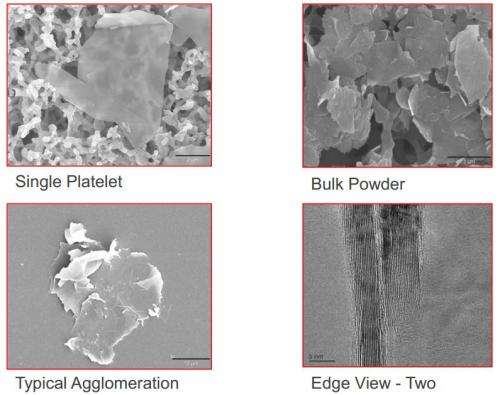April 13, 2013 report
XGS presents new silicon-graphene anode materials for lithium-ion batteries

(Phys.org) —XG Sciences (XGS) this month announced new anode materials for lithium-ion batteries. These will be viewed with interest among those watching the battery marketplace, where any promising news on battery breakthroughs is always welcome. XG Sciences said it has a new battery anode that is four times the capacity of conventional material—that is, anode materials for lithium-ion batteries with four times the capacity of conventional anodes. The anode material uses xGnP graphene nanoplatelets to stabilize silicon particles in a nano-engineered composite structure. XG Sciences makes these nanoplatelets through techniques that allow for control of their size and surface characteristics. Graphene anode material, when combined with xGnP graphene products as conductive additives, provides higher energy storage than do conventional battery materials, according to the company.
Rob Privette, XG Sciences vice president, energy markets, said the announcement may be considered as good news regarding a range of lithium-ion battery-using applications such as tablets, smartphones, and vehicle electrification. "We are working with battery makers to translate this exciting new material into batteries with longer run-time, faster charging and smaller sizes than today's batteries," he said.
The company has a history typical of a number of startups, in their growth from labs projects to businesses. XG Sciences has focused on xGnP graphene nanoplatelet technologies for some years, since the company's start in 2006. Actual research began in the College of Engineering at Michigan State University. More recently, XG Sciences expanded its network of distributors to Korea, Japan, Taiwan, China, and Europe. Half of the Lansing, Michigan, company's customers are located outside the United States.
"We expect initial adoption in the highly-competitive consumer electronics markets," Privette said, but the company also has research and development partners focused on hybrid and electric vehicles, grid storage, military, and specialty industrial applications. Mike Knox, CEO of XGS, said he wanted to thank the U.S. Department of Energy for supporting the company's development of anode materials for extended range electric vehicles.
The exact performance of the new anode materials will depend on the specific battery formulations used by the cell manufacturer, according to the company. XGS has demonstrated capacity of 1500 mAh/g with low irreversible capacity loss and stable cycling performance in life tests.
More information: xgsciences.com/
© 2013 Phys.org




















